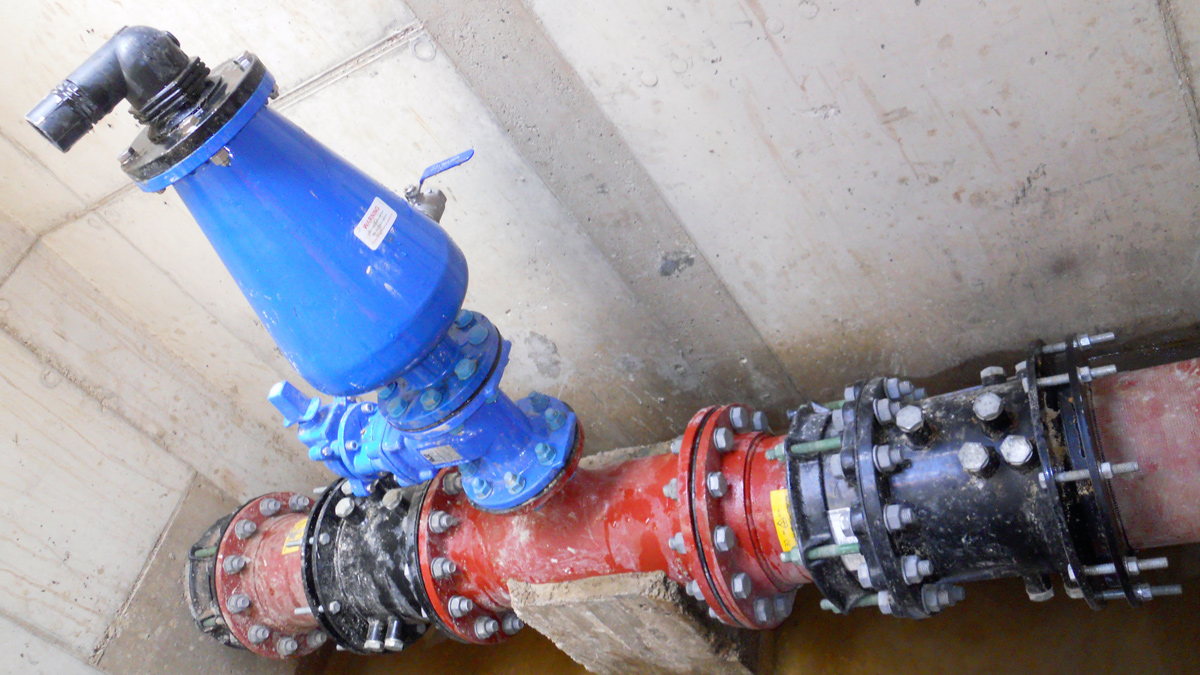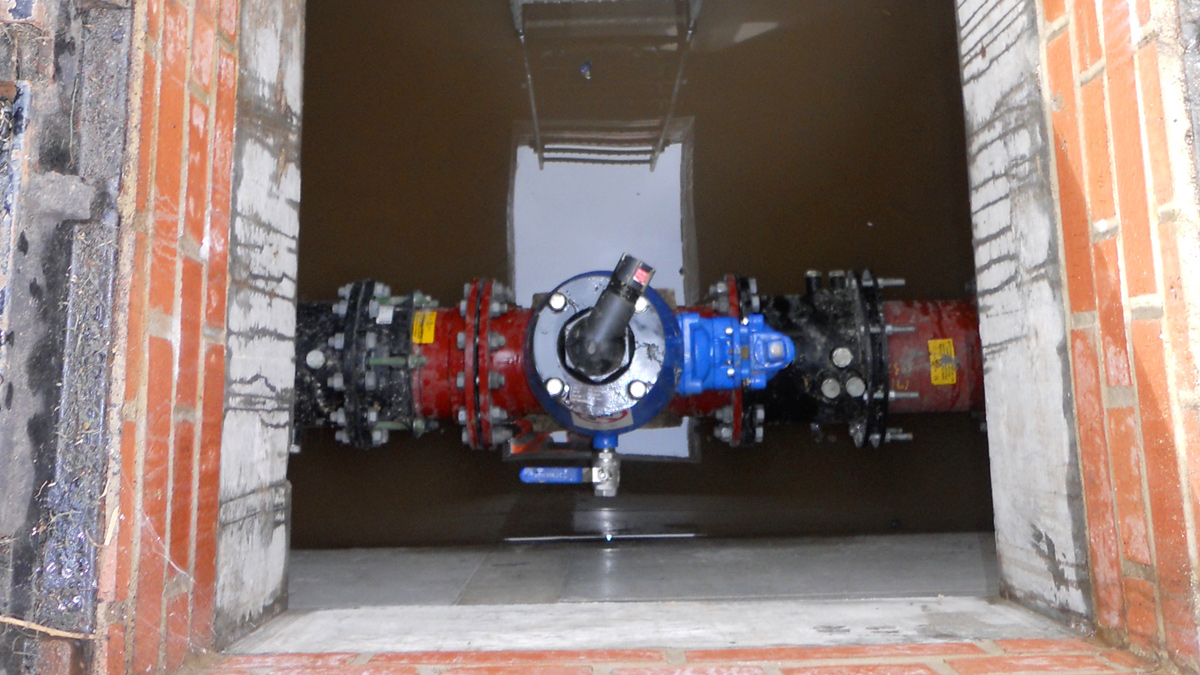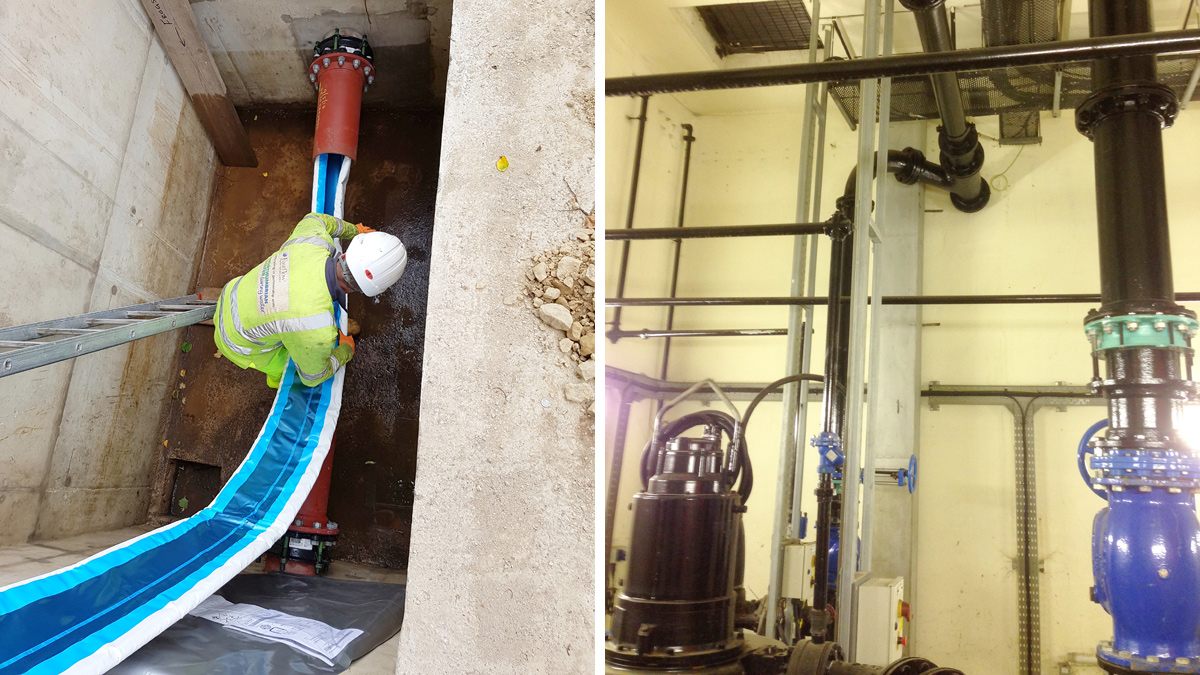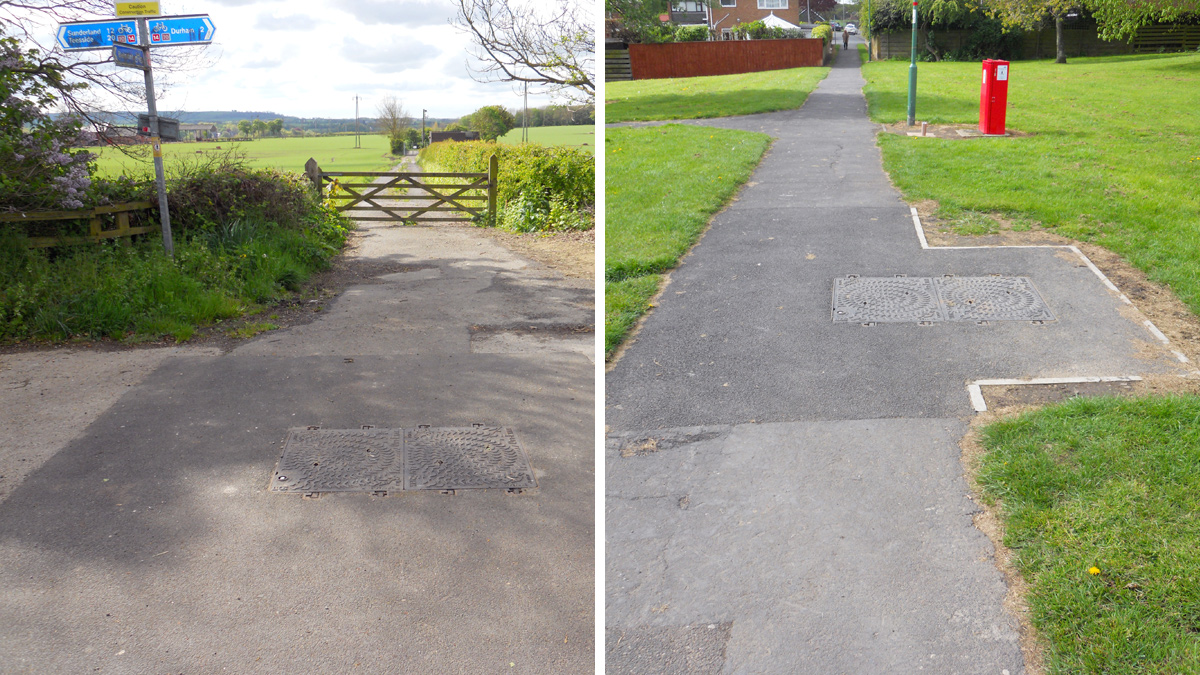Renny’s Lane Foul Sewer Rising Main Replacement (2019)

New air valve with V33 transition adaptors - Courtesy of MMB
Renny’s Lane Sewage Pumping Station (SPS) is located in arable farmland to the south of the Belmont and Carville residential estate, north east of the City of Durham. The pumping station has two parallel rising mains which transfer combined flows into the gravity sewerage network which ultimately drains to Belmont Sewage Treatment Works (STW). The 200mm diameter, cast iron rising main transfers dry weather flow (DWF) whilst the 500mm diameter, ductile iron rising main transfers storm flows. The pumping station has 5 (No.) dry well pumps, 2 (No.) DWF pumps operating in duty/assist and 3 (No.) storm pumps operating in duty/assist/standby. The population equivalent for the Renny’s Lane SPS is 5,417.
Introduction
Both rising mains exit the pumping station in a northerly direction and are initially laid within an access track before they cross Renny’s Lane and enter the residential housing estate. Within the estate the mains cross within very close proximity to, and within the boundary of some private properties. The rising mains finally discharge into separate manholes in the grounds of the Belmont School. Northumbrian Water (NW) records indicate that the 200mm DWF main was laid in 1956 and the storm main was constructed in 1976.
The 200mm rising main has suffered from nine bursts since 2002, with five bursts occurring within a nine month period between November 2011 and July 2012. Following the most recent burst on 19 July 2012, the 200mm rising main was temporarily isolated from service. The storm main has since been used for all flows and there have been no recorded bursts on this main.
The notional solution provided by NW at the start of the scheme recommended replacing the 200mm DWF main over the 635m total length, including the corroded section of main which is bridging the storm tank chamber at the Renny’s Lane SPS.
The notional solution recommended replacing the full length of main with a similar bore polyethylene pipe.
Mott MacDonald Bentley (MMB) were appointed to investigate the viability of a notional solution for replacement of a 635m length of 200mm cast iron foul sewer rising main, and through challenge, innovation and consideration of value-added alternatives, define a preferred solution which delivers a sustainable business outcome at least cost.
Notional solution and preferred option
The initial investigations concluded that although viable, the notional solution for a rising main replacement had a number of significant hazards and constraints. The rising main passes through an access road that leads to a cul de sac where no alternative access to the affected residential properties was possible.
In places the easement was very narrow and congested with services which would have required diversions or a trenchless solution to install the new main at significant depth below these. A deep trenchless solution would have made future access for maintenance or repairs very difficult and following discussions with the Core Team this option was discounted by NW.
A high-level options appraisal was carried out by MMB which included the following solutions:
- Re-lining the full rising main.
- Part lining and open cut sections.
- Directional drilling.
- A part directional drill and open cut solution.
- Full open cut replacement.
- Pipe bursting.

Access to new air valve chamber – Courtesy of MMB
The option of abandonment of the 200mm rising main and utilising the 500mm rising main for both DWF and storm flows was also discounted as this did not provide enough resilience for NW, is less efficient, and the larger main would be more susceptible to corrosion issues associated with septicity during low flows.
The most economical solution agreed with the Core Team, which had less customer and third-party disruption and impact, was the re-lining of the full length of the rising main with just a short length of on-line replacement at the Renny’s Lane SPS dry well where the pipework spans locally across the storm tank structure.
CCTV and jetting works were carried out along the main to confirm the locations of any bends and internal bore restrictions which may influence the lining works. This confirmed 2 (No.) 45° bends close to the pumping station which could not be re-lined.
Design and construction stage
Following agreement of a target cost in the Investigate and Define (I&D) stage, NW commissioned MMB to deliver the defined solution through a Design and Construction contract under Option C of the NEC Contract.
The agreed final preferred solution was to replace the initial 15m section of rising main (from the pumping station to the second 45° bend) via an open cut trench excavation in 200mm ductile iron. The remaining length of rising main was re-lined using a structural CIPP liner (UV cured). This rising main discharges as before into the existing manhole located in the Belmont School grounds (approximately 620m total length). The final solution also includes full replacement of the corroded section of ductile iron main which is bridging the storm tank chamber from the dry well to the outer storm tank wall.
In order to utilise the CIPP liner system the relining works had to be divided into 4 installation sections with a maximum length of 200m on each insertion. V33 Transition adaptors which have been developed by PMP Utilities for the gas industry, enabled the connections of these sections to be made at the on-line hatch box and air valve chambers along the rising main length. Two of these V33 adaptors were used in each chamber. These adaptors securely grip the existing CIPP lined pipes, completely sealing the annulus of the parent pipe and the liner inside it with a resin grout, whilst providing a new flange to enable a new connection to be made to the existing host pipe. These adaptors were used in conjunction with stainless steel Amex 10 seals on the inside of the pipe at the cut ends of the CIPP liner.
The works included installation of three new chambers, with a new hatch box chamber and two new air valve chambers. These were positioned in easily accessible areas for future maintenance alongside footpaths avoiding access roads and also avoiding the need for any traffic management, resulting in less disruption to residents during construction. The maximum operating pressure in the new main was 4 bar with a test pressure of 6bar.
The site works commenced in February 2018 and were completed in October 2018.

(left) New CIPP liner installation and (right) Renny’s Lane SPS dry well – Courtesy of MMB
Surge analysis
A hydraulic model of the system was built in WANDAv4.5 based on the construction issue drawings of the plan and long section profile and a reduced diameter of 184mm allowing for the installed liner system. The Darcy-Weisbach equation was used in the analysis with a new pipe roughness value of 0.03mm (worst case transient). The Renny’s Lane SPS Flygt NT3171-MT-432 duty / assist DWF pumps were used in the model with a head of 22m and a flow rate of 38 l/s for one pump and 48 l/s for two in parallel. Based on the technical information from the liner supplier the liner system is suitable for pressure variations between 9 and -0.7 bar.
In steady state analysis the pressures predicted are within the pressure limits assumed. The transient analyses were also carried out to determine the maximum and minimum surge pressures throughout the system. This recommended installation of a fast-acting air valve at the pumping station dry well outlet and an air valve at Chamber 1 (chainage 182.5m). After the pumps trip the pressures will range between -0.4 to 4.3 barg which are within the pressure limits adopted. Although the importance of air valve maintenance cannot be under estimated, to provide some redundancy in the system an additional air valve was introduced at Chamber 2 (chainage 332.3m).
Renny’s Lane Foul Sewer Rising Main Replacement: Key participants
- Client: Northumbrian Water
- Principal designer & main contractor: Mott MacDonald Bentley
- CIPP liner supplier & installer: ARM Pipetek
- V33 transition fitting manufacturers & installers: PMP Utilities Ltd
Conclusions
This design and construct contract was substantially completed on programme and at just over the contract budget of £0.472M. By challenging the notional solution and utilising a CIPP liner system in conjunction with V33 Transition adaptors, significant efficiencies and benefits were realised.
Overall efficiencies of circa £0.6M with this low carbon footprint solution were achieved by avoiding the need for a rising main replacement and by maximising the use of existing assets. Customer access and associated disruption issues were avoided using this ‘no dig’ re-lining solution. There was significantly less works therefore required within the school at the discharge end of the rising main and all service diversions and crossings were avoided. The customer engagement and feedback was excellent on this scheme with over 600 letter drops within the estate. This included close liaison with one resident where we had to access their garden to excavate down to remove a flap valve. Regular liaison with the school was also important where we agreed to restrict our works in their property to after school hours to help minimise any impact.

(left) Access to Renny’s Lane SPS and (right) new air valve location – Courtesy of MMB
NW are pleased with the outcome from this project which has demonstrated the benefits of collaborative team working and a proactive approach to challenge the notional solution from an early stage. The rising main has now been operating for over 6 months with no problems reported. NW/MMB believe that this is the first use of this rehabilitation method for a public wastewater rising main, and there are potential opportunities to consider this on a wider national basis. This scheme won an NW 2019 VIVA Innovation award for this new and innovative solution for rising main rehabilitation bringing lessons learnt from the gas industry.





